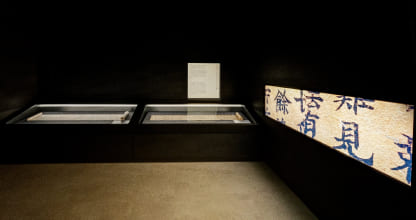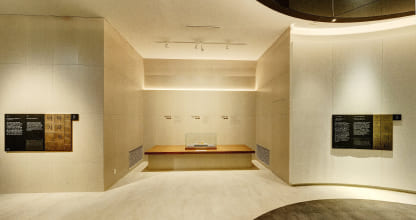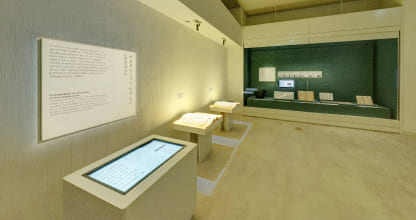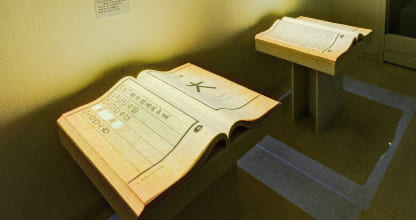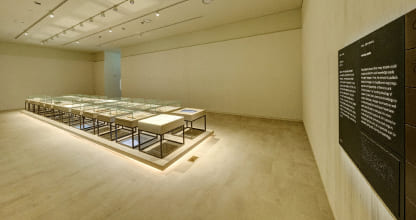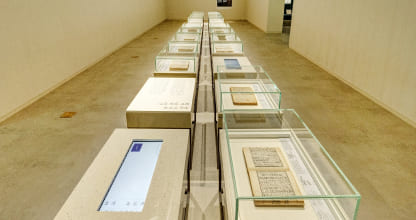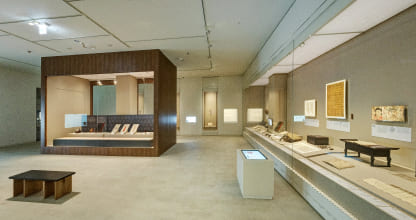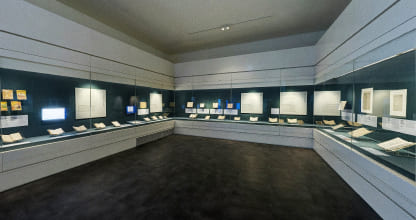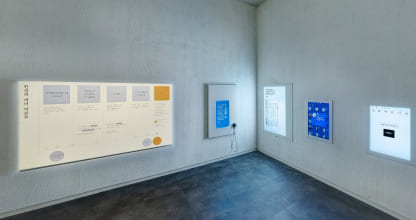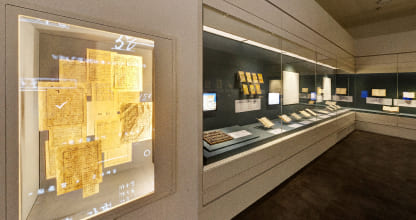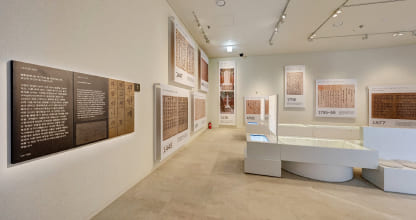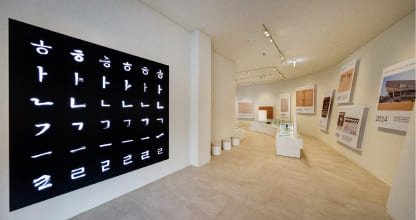 이 누리집은 대한민국 공식 전자정부 누리집입니다.
이 누리집은 대한민국 공식 전자정부 누리집입니다.
Hunminjeongeum, The Design of a Writing System Beyond Millennia
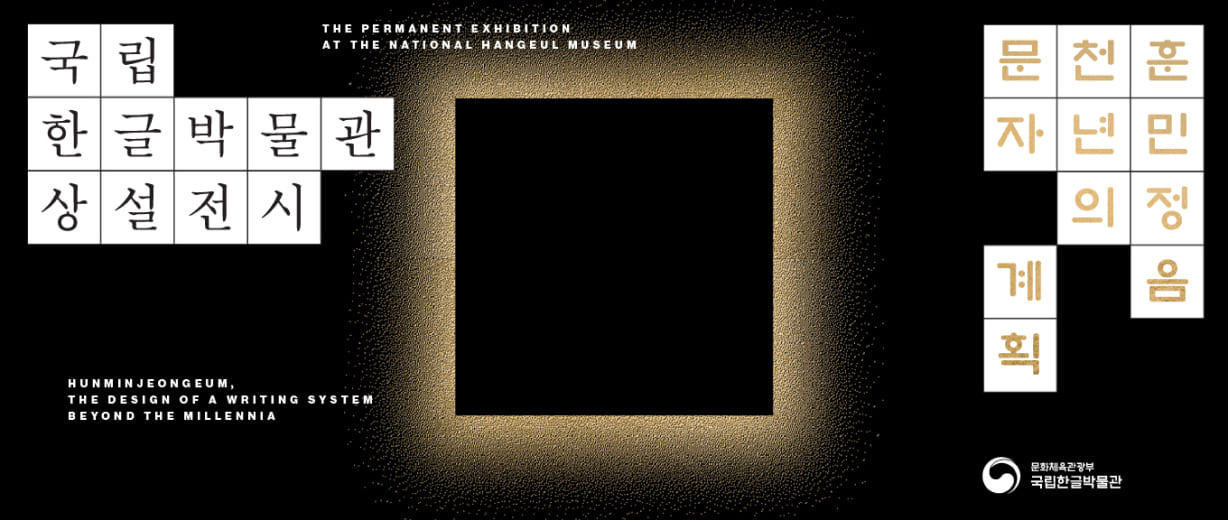
- Location
- Permanent Exhibition Hall (2F)
In 1443, King Sejong created our writing system, 'Hunminjeongeum'. In 1446, he published a book titled Hunminjeongeum, which explained the purpose and principles behind the new writing system. The preface of Hunminjeongeum outlines the new world that King Sejong envisioned through the use of 'Hunminjeongeum'. The exhibition hall is divided into seven sections, each corresponding to a sentence from the preface of Hunminjeongeum.
-
The language of the country is different from that of China
In Sejong's era (世宗, 1397~1450), the Korean language was vastly different from Chinese. Nevertheless, due to the absence of a writing system to write Korean, people had to resort to using Chinese characters. This unfortunate situation was not unique to Korea; many other nations and ethnic groups in East Asia faced similar circumstances. In Korea, adaptations like 'Idu (吏讀)', 'Gugyeol (口訣)', and 'Hyangchal (鄕札)' were employed to transcribe Korean using Chinese characters. However, these methods were as difficult and inconvenient as wearing ill-fitting clothes. Most people, except for a few who learned Chinese characters, remained illiterate
-
Pitying such circumstances
King Sejong created Hangeul for his people, who were unable to communicate their thoughts and suffered injustice because they didn’t know how to write and read. When literacy was power, it was remarkable that a king with so much power created an easy writing system accessible to everyone. The creation of Hangeul was rooted in King Sejong's deep love for his people, his desire to have our own writing system distinct from Chinese, and his practical approach to creating a useful writing system in real life.
-
Making twenty-eight letters
In 1443, King Sejong created Hangeul, initially called 'Hunminjeongeum.' It consisted of 28 letters: 17 consonants and 11 vowels. Designed for easy learning and use, Hangeul had a very simple shape and a small number of letters to suit its purpose. The five basic consonants, modeled after the shapes of the pronunciation organs, expanded to 17 by adding strokes according to the intensity of the sound. The three basic vowels, modeled after the shapes of heaven, earth, and human beings, combined to form 11 letters. Sejong's simple and convenient 28-letter writing system was intended as a compassionate and communicative tool, easy enough for “The wise to learn in a morning and The less wise in ten days.”
-
Learning easily
King Sejong hoped that his people could study and learn knowledge easily through Hangeul. Therefore, in the early years of its creation, Buddhist scriptures, reflecting the widespread influence of Buddhism at the time, were published in Hangeul. Later, Confucian scriptures were also translated and written in Hangeul to promote the governance ideology of the Joseon Dynasty. Continuing Sejong's vision, practical knowledge on famine food, disease, and martial arts, as well as institutions and laws, was disseminated in Hangeul after the Imjin War in the late 16th century. As printed materials, which were mass-produced at the national and institutional level, spread across regions and became an essential tool for disseminating and sharing knowledge.
-
Each person
King Sejong envisioned a society where everyone could communicate freely in Hangeul, regardless of status or gender. Contrary to the general misconception that only the lower classes and women used Hangeul, it was actually used by a diverse range of people, from royalty to slaves. There are records of royal family members exchanging letters in Hangeul and documents written by noblewomen to complain about injustice in Hangeul. Hangeul was also used to label everyday items with quantities or owners' names and to produce various literary and practical books containing the pleasure and sorrows of life and wisdom. As Hangeul permeated daily life, it became a communication tool for all people to share their thoughts and emotions.
-
Using daily
The Hangeul created by Sejong in 1443 became the official national writing system only in 1894, more than 450 years later. Until then, official documents were still predominantly written in Chinese characters. This was a newfound of prominence in the writing life of the country. The pleasure of Hangeul's official recognition was short-lived, as Korea was lost to Japan in 1910, and Hangeul lost its status as the national writing system. We were unable to freely use Hangeul, which we take for granted today. However, despite the Japanese suppression, intellectuals of the time, understanding that a nation’s identity comes from its language and writings, continued to conduct research, policy, education, and literary activities on Hangeul. Finally, they were able to protect our own language and writings.
-
Convenient to use
As King Sejong wrote at the end of the preface of Hunminjeongeum, he envisioned a world where Hangeul would enable better literacy and communication, which in turn would lead to a better life and culture for everyone. Various notation policies were established post-liberation in 1945 to ensure accurate Hangeul communication. Discussions on more convenient and efficient uses of Hangeul, such as combined and separated writing or horizontal and vertical writing, took place. Through research on calligraphy, visually pleasing and readable Hangeul fonts were developed. Hangeul has continuously evolved to be user-friendly, becoming the most important tool for cultural creation and communication. As King Sejong wished, Hangeul has become a proud Korean writing system for all, including late learners, the physically handicapped, and those from different linguistic backgrounds.
Phone: 02-2124-6354
footer section
 Reservation
Reservation



